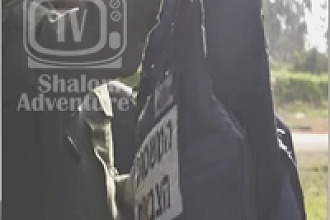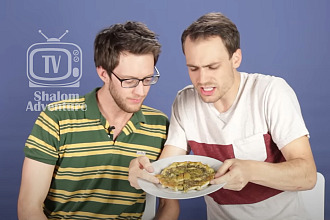Havdallah means “separation” and is a service used to separate the holiness of the Sabbath from the rest of the week. It separates the day that God blessed from the regular workdays of the week. It is also a reminder to us that there is a difference between the holy and the secular. That would include time such as the difference between the Sabbath and the rest of the week, but also the difference between kinds of activities such as the difference between worship and work.
There are also sacred relationships and secular relationships, such as the covenant a married couple have with each other in comparison to their relationships with others. There is a difference between the Holy Scriptures and other books. The secular is not automatically bad because it is not sacred. The six non-Sabbath days of the week are good, work is good, friendly relationships outside of marriage are good, etc., but yet they are different from the sacred.
There is also a difference between the commandments of Scripture and traditions – even godly traditions. The havdallah service is a tradition; it is not mentioned in the Scriptures. It is a beautiful service, but it is not commanded by Scripture. The Sabbath is God’s sacred, set-apart, holy time. The ceremonies by which we bring in the Sabbath or close the Sabbath are traditions. There is a difference between the two, a difference between the commandments and the traditions. Often history has shown that we humans tend to lose the balance between the sacred and the tradition. We may either throw out the sacred altogether or replace it with ceremonies and traditions. In this book we are seeking to teach both the Scriptures and the traditions of our Jewish Heritage, because both are helpful. We are also attempting to reveal the difference, separation, or havdallah, between the two.
Just as we bring in the Sabbath with candles and with a glass of juice from the grape (many traditions use alcoholic wine; others use grape juice), we also close out the Sabbath in a similar way. The candles are different in the havdallah service. What is done with the juice is different, and there is an added dimension of the spice box. We exit the Sabbath, the final day of Creation, by using our sense of taste, smell, and sight. We taste the juice and smell the herbs and spices that God has created, and we look at the light, the first thing God created. The Sabbath is a memorial to the Creator and thus we bring in the Sabbath and say goodbye to the Sabbath with our senses and reminders of His Creation.
Traditionally the havdallah service does not begin until three stars can be seen in the sky, bringing an end to the Sabbath.
The traditional blessing is said over the wine or juice: “Baruch atah Adonai, Elohenu Melech ha’olam, borei p'ri hagafen.” “Blessed are You, Adonai our God, Ruler of the universe, Creator of the fruit of the vine.”
The juice can represent life. One of the toasts we say as we drink together is L’Chaim – to life. The Torah mentions “Shiloh” coming, a reference to the Messiah (Genesis 49:10), and Him washing His clothes in the blood of the grape. The Torah also says “the life… is in the blood” (Lev. 17:11). As the blood on the doorposts in Egypt gave life to the first born on the first Passover, so also the blood the Messiah shed for us gives us eternal life.
A blessing is said over the spice box (a box or jar that is filled with fragrant spices, clover, or herbs): “Baruch atah Adonai, Elohenu Melech ha’olam, borei minei v'samim.” “Blessed are You, Adonai our God, Ruler of the universe, Creator of all kinds of spices.” The spices also remind us of our Creator, the giver of life. We sniff the spices and hold the smell in our nostrils, not wanting the Sabbath to leave.
A special havdallah candle is lit. The havdallah candle consists of at least two candles woven together or braided together like the challah bread that we use at the start of the Sabbath. “Baruch atah Adonai, Elohenu Melech ha’olam, borei m'orei ha'eish.” “Blessed are You, Adonai our God, Ruler of the universe, Creator of the lights of fire.”
The braided havdallah candle is a wonderful symbol of unity, of oneness, even in plurality, more than one candle braided as one and burning as one. It is a beautiful symbol of the oneness of Elohim. It is a beautiful symbol of the oneness He is wanting us to have with Him, a beautiful symbol of the oneness He wants us to have with each other.
Some of the juice is sipped and then the havdallah candle is extinguished in the juice. As the life of the Messiah was extinguished for a time by His death, the Sabbath light is extinguished by the juice for another week until we light it again and enter into its rest again the following Sabbath.
The song Eliyahu Hanavi is traditionally sung at the close of the Sabbath. This beautiful song, thousands of years old, calls for Elijah the prophet to come soon with the Messiah the son of David.
| Eiliyahu hanavi, Eiliyahu hatishbi, |
| Eiliyahu, Eiliyahu, Eiliyahu hagiladi. |
| Bim'heira v'yameinu, yavo eileinu; |
| Im mashiach ben David, im mashiach ben David. |
| Elijah the prophet, Elijah the Tishbite. |
| Elijah the Gileadite. |
| Soon, in our days, he will come to us |
| with Messiah, son of David. |
Originally from: Jewish Discoveries by Jeff Zaremsky, pages 100-104, which contains a total of 22 fascinating chapters of biblical history and lessons plus 25 rich Jewish tradition sections, and 27 powerful testimonies, with over 40 beautifully rendered professional works of art all on over 300 jam packed pages. You can own this treasure by visiting Jewish Discoveries.


























